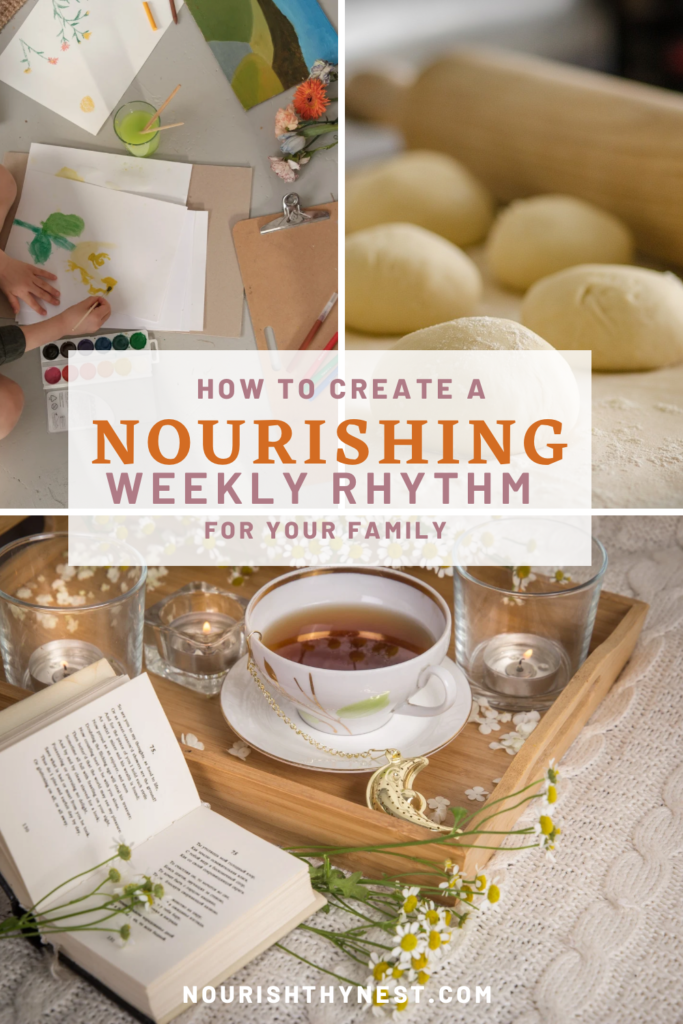
This blog is reader supported, and some of the links in this post are affiliate links, meaning, at no additional cost to you, I will earn a commission if you click through and make a purchase. As an Amazon Associate I earn from qualifying purchases
In a couple of recent posts we discussed how nourishing it can be for a family to follow a Seasonal Rhythm, as well as a Daily Rhythm. In this post we are going to expand a bit more, and talk about creating a Weekly Rhythm which exists within the container of the Seasonal Rhythm. The Daily Rhythm then exists within the container of the Weekly Rhythm. When these rhythms are joined together, you then have a complete Yearly Rhythm for you and your family to follow.
Much like a Seasonal Rhythm and a Daily Rhythm, the Weekly Rhythm also provides anchor points for our experience of life.
Excerpt from my Seasonal Rhythm post:
“An anchor point is like the beating of a drum, where each time you feel the beat of it, you experience the rhythm’s anchor point.
It grounds you in the music.

As that beat repeats, over and over again, you come to expect and anticipate the next beat of the drum.
Instead of the beat of a drum creating the anchor points, you create them by establishing daily, weekly, and seasonal anchor points that your family comes to know and expect.
In the Waldorf pedagogy that our family life is largely inspired by, rhythm creates the foundation of a child’s life experience from an early age.
Storytelling, art, and music, as well as the art of caring for home and hearth are woven into the child’s daily rhythm within the container of a seasonal rhythm.
The container of these rhythms are what create a sense of harmony within your home that in turn allow your children to flourish.”
We can get an idea of what this means by doing a little breathing exercise:
Start by breathing in and breathing out, slowly and evenly.
Breathe in…
Breath out..
In…and out.
This is rhythm.
This is the feeling we want to nourish within ourselves and within our home.
Excerpt from my ‘Seasonal Rhythm’ post:
“Children thrive when they are nourished by rhythm, when they can anticipate and know what to expect both in their daily lives and in the yearly wheel of life.
It allows them to rest in knowing that their world is a safe and nourishing place.
When children experience the deep sense of safety and security that rhythm brings their brains can open to their natural curiosity, imagination, and learning.
When parents create rhythm for themselves and their family it can help reduce stress levels, and build connection between family members when everyone participates in the rhythm together.”
Recently I have been taking Dr. Laura Markhams’s Peaceful Parenting Online Course, and in one of the audio lectures she talks about how, according to research, it actually helps pre-frontal cortex development and the development of executive functioning when children follow a predictable routine. (Read more here)
And rhythm is another form of routine.
We all know how crucial those executive function skills are in life, since they are responsible for our ability to plan ahead, organize, and also regulate our emotions!
After hearing this, I had an “Aha!” moment, and realized that THIS must be one of the main reasons why following these rhythms nourishes our children so much.
I have seen it firsthand with my own kids, and it has been truly amazing to witness their response.
So without further ado, here is how to create your own Nourishing Weekly Rhythm.. and it’s so, so simple!
If you don’t homeschool or aren’t a full-time parent at home with young children, you probably already follow some kind of weekly and daily routine. Between school, and then weekly after school activities, you probably already have days of the week designated for certain activities.
For instance, I have one child who attends a brick and mortar school, and her week looks like this:
Monday:
Daytime: Morning chores, Breakfast, and off to School
After school: Free time, family dinner time, homework after dinner, evening chores, and bedtime
Tuesday:
Daytime: Morning chores, Breakfast, and off to School
After school: Ballet class, family dinner time, homework after dinner, evening chores, and bedtime
Wednesday:
Daytime:Morning chores, Breakfast, and off to School
After school: Weekly get together with friends, family dinner time, homework after dinner, evening chores, and bedtime
Thursday:
Daytime:Morning chores, Breakfast, and off to School
After school:
Study Hall at school for an hour, until dad comes to do pick-up from study hall after work, followed by their weekly dinner date together, evening chores, and bedtime.
Friday:
Daytime: Morning chores, Breakfast, and off to School
After school: Free time until Family Shabbat Dinner, evening chores, and bedtime.
Saturday & Sunday:
Ballet class, household chores (which I actually refer to as “contributions” in our home instead of chores), and family time.
If this is sounds like your week, then great! You have a rhythm!
All that’s left to do is add in a few simple seasonal anchor points if you haven’t already, and then make sure that your children have as much free play time or unscheduled time as possible so that their brains can process and solidify the skills they are learning. (Research supports this!)
If your children are in school, but the afternoons seem chaotic and you don’t have predictable after-school activities, homework time, dinner time, and bedtime, then I suggest you begin creating an after-school rhythm.
First write down what things must happen after school.
Then decide how best to order them.
For instance:
1. After school snack
2. Free play
3. Family Dinner
4. Homework
5. Bedtime
And done! Just guide the flow of this new rhythm for your family each afternoon, and you’re all set.
Now, if you are a stay at home parent with young children at home, or are homeschooling read on…

For my younger child whom we are homeschooling, the week looks a bit different, as we are home together most of the day.
We follow a Daily Rhythm within our Weekly Rhythm and Seasonal Rhythm.
Our Daily Rhythm follows a pattern of “Breathing In” and “Breathing Out” activities that make our day more fluid, predictable, and calm because we know what to expect.
You can read more about our Daily Rhythm here.
However, what makes the weekly rhythm different from the daily rhythm is that we do a daily learning activity that changes for each day of the week, and then repeat the same pattern every week.
Which looks like this:
Monday :
Daily learning activity: Form Drawing
Tuesday:
Daily learning activity: Handwork/Crafting
Wednesday:
Daily learning activity: Beeswax modeling
Thursday:
Daily learning activity: Painting
Friday:
Daily learning activity: Baking
Saturday & Sunday: Family Time
These activities we do each day, are done in about the same order so that everyone knows what to expect, and the variation from day to day prevents monotony, while still maintaining that sense of predictability.
It is ordered, but feels very fluid because nothing need happen at a set time, so there is room for your children to experience and explore their own natural curiosity and creativity.
And again, children thrive when they can rest in the feeling of nourishment and safety that rhythm provides.
Here are some simple steps you can take to create a Weekly Rhythm that works for your family:
- Grab a sheet of paper and list out all the activities that must happen at a specific time each week (appointments, dance classes, gymnastics, or anything else done outside of the home). Then decide what additional daily activities you plan to do (drawing, painting, baking, etc.) and decide which day of the week you will do this on.
- List out the other daily chores, lessons, and activities that you would like to include in your week
- Arrange them, one activity for each day of the week, for instance:
– Monday: Baking/Culinary Day
– Tuesday: Handwork/Crafting Day
– Wednesday: Nature Day/Park Day
– Thursday: Painting Day
– Friday: Family movie
Saturday & Sunday: Housecleaning and Family Time
Please keep in mind that there will be “off days”, like when the kids get sick, or you have to make a last minute appointment, or the laundry pile needs to be dealt with more than anything else on a given day (or is that only in my house??).
And that is ok.
This is just a guide to follow, and shouldn’t be something to stress or worry about.
We all have enough stress in our modern lives…no need to create any more, right?
And our family still connects to that rhythm in spite of it getting derailed sometimes!
I’m sure yours will too.
So please give yourself and your family the space to be gentle about your rhythm and be flexible and fluid wherever you need to.
That is the true secret of a successful rhythm.
~xo
Did you create a Weekly Rhythm for your family? Share your experience in the comments!


2 thoughts on “How To Create A Nourishing Waldorf-inspired Weekly Rhythm For Your Family”